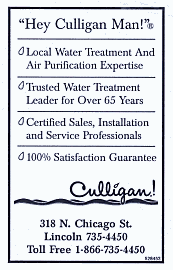|
"The most important factor to control
when spraying for soybean rust will be spray droplet size,"
Bretthauer said. "Small spray droplets provide better coverage and
tend to deposit well on the target, but if droplets are too small
they will be unable to penetrate and deposit in the canopy, or they
may drift off target." He
notes that large droplets will not deposit as well because they have
a tendency to bounce or run off the plant, and there will be fewer
droplets, which reduces the coverage.
"The key is to create the droplet
size that gives a good balance of coverage, penetration and
deposition," Bretthauer said. "A nozzle produces a range of droplet
sizes, known as the droplet size spectrum. A medium droplet spectrum
is recommended for making applications to control soybean rust."

Bretthauer points out that the
droplet spectrum can be controlled by selecting and correctly using
the proper nozzle. The droplet spectrum created by a nozzle is a
function of the nozzle design, the size of the opening and the
operating pressure.
"In general, nozzles with large
openings produce larger spray droplets, while nozzles with smaller
openings produce smaller spray droplets," he said. "As pressure is
increased, smaller droplets are created. Using low pressures reduces
the amount of small spray droplets."
Bretthauer suggests using a nozzle
manufacturer's catalog to select a nozzle size and operating
pressure that will create the desired droplet spectrum of medium as
well as deliver the required nozzle flow rate in gallons per minute.
"An application rate of 15 gallons
per acre or higher is recommended for ground applications, but don't
fail to create the right droplet spectrum when applying at higher
rates," Bretthauer said. "If necessary, use a slower sprayer speed
to achieve the correct rate and droplet spectrum."
Another important consideration is
the style of nozzle tips used to spray for control of soybean rust.
"Although hollow cone nozzles can be
used to make fungicide applications, they create a great deal of
very small droplets that will not penetrate dense plant canopies,"
Bretthauer said. "Extended-range, flat-fan nozzles create smaller
droplets in the higher end of their pressure operating range, but
applicators should be sure not to exceed the upper pressure limit."
While air-induction nozzles are
often considered only as drift control nozzles, there are several
designs that produce fine and medium droplet spectrums. Research in
peanut canopies has shown that air-induction nozzles can provide
good canopy penetration.
[to
top of second column in this article]
|

"Air-induction nozzles are designed
to work at higher pressure than other flat-fan nozzle designs and
should be operated according to the manufacturer's recommendations,"
Bretthauer said. "The research in peanuts also showed twin spray
nozzles work well for achieving good canopy penetration and target
coverage."
Twin spray nozzles produce two
flat-fan patterns, one angled forward and the other angled backward.
There are two designs available: single tips with two openings and
modified caps that hold two individual nozzle tips.
"With these caps, the applicator can
chose the type of nozzle to use, such as an air-induction tip,"
Bretthauer said. "Sprayers with air-assisted booms have been shown
to provide excellent canopy penetration and spray deposition. It is
important to match the air flow rate to the canopy [so] as not to
increase the risk of drift."
He notes that aerial applications
have given excellent control of soybean rust in South America. By
changing deflector angle or orientation of an aerial nozzle, the
droplet size spectrum can be altered.
Bretthauer points to the Aerial
Spray Nozzle Models, [caps?] developed by the USDA Agricultural
Research Service's Aerial Application Technology Research Team at
College Station, Texas, as a valuable tool that aerial applicators
can use in setting up their aircraft.
"By entering the nozzle type,
orifice size, nozzle or deflector angle, pressure, and air speed,
the model calculates the droplet spectrum and other valuable
information," he said. "This allows an aerial applicator to set up
the aircraft to create the droplet spectrum required for a job. Good
control of droplet size is one of the reasons agricultural aircraft
can successfully make soybean rust applications at five gallons per
acre."
He adds that agricultural aircraft
also have the advantage of speed and the ability to spray when field
conditions are too wet for a ground sprayer. While keeping the boom
as low as possible works well for ground applicators, Bretthauer
notes that flying too low can actually increase drift and reduce
deposition for aerial applicators.
"An ideal height for aircraft to fly
is often between 10 and 14 feet above the canopy," he said. "Any
higher and the droplets are excessively exposed to wind. At lower
heights, droplets can become trapped and carried off in air
turbulence caused by the aircraft flying so close to the crop
canopy. Whether using aerial or ground applications, it is important
to follow the proper guidelines as closely as possible."
[University of Illinois news release] |